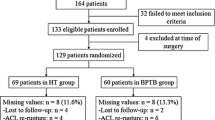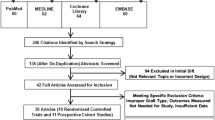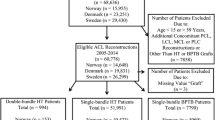Abstract
Purpose
The purpose of this study was to determine the anterior cruciate ligament reconstruction (ACLR) failure rate in young patients utilizing the New Zealand (NZ) anterior cruciate ligament (ACL) Registry. The hypothesis was that the ACLR rupture rate would be lower for thicker hamstring graft and bone patellar tendon bone (BPB) grafts in comparison to the classic hamstring technique. The ACLR failure rate was assessed according to graft type and patients’ sex.
Methods
The NZ ACL registry was utilized to identify all patients aged 20 years or younger at the time of surgery who were skeletally mature and had a minimum 2-year follow-up. Graft ruptures, defined as an ACL revision, were identified according to graft type (traditional 4 strands hamstring semitendinosus and gracilis, 4 strands semitendinosus, 5–6 strands semitendinosus and gracilis, 7–8 strands semitendinosus and gracilis, bone-patella-bone graft).
Results
Nine-hundred and ninety-two patients were included. At a mean follow-up of 38 months, 52 cases of graft rupture were recorded, (overall failure rate: 5.2%). The failure rate was not statistically influenced by the graft diameter. Patients with a thinner graft (< 8 mm—196 patients) had a similar failure rate (6%) to patients with a thicker graft (8 mm or more—485 patients) (6.2%). There was a lower failure rate in the BPB group (3.1%) versus all hamstrings group (6%) (ns). Finally, BPB in females had a lower failure rate than all hamstring constructs together (0% versus 5.1%; p = 0.023)
Conclusion
In a young population traditional four-strand hamstring grafts, multiple strand configurations or BPB ACLR, whatever their size (> or < 8 mm), showed no significant difference in the failure rate in the NZ ACL registry. Female patients who had an ACL reconstruction with BPB graft had a significant lower failure rate than patients who had a hamstring graft.
Level of evidence
III.
Similar content being viewed by others
References
Astur DC, Cachoeira CM, da Silva VT, Debieux P, Kaleka CC, Cohen M (2018) Increased incidence of anterior cruciate ligament revision surgery in paediatric verses adult population. Knee Surg Sports Traumatol Arthrosc 26:1362–1366
Bressy G, Brun V, Ferrier A, Dujardin D, Oubaya N, Morel N, Fontanin N, Ohl X (2016) Lack of stability at more than 12 months of follow-up after anterior cruciate ligament reconstruction using all-inside quadruple-stranded semitendinosus graft with adjustable cortical button fixation in both femoral and tibial sides. Orthop Traumatol Surg Res 102:867–872
Clatworthy M, Sauer S, Roberts T (2019) Transportal central femoral tunnel placement has a significantly higher revision rate than transtibial AM femoral tunnel placement in hamstring ACL reconstruction. Knee Surg Sports Traumatol Arthrosc 27:124–129
Cordasco FA, Black SR, Price M, Wixted C, Heller M, Asaro LA, Nguyen J, Green DW (2019) Return to sport and reoperation rates in patients under the age of 20 after primary anterior cruciate ligament reconstruction: risk profile comparing 3 patient groups predicated upon skeletal age. Am J Sports Med 47:628–639
Ekeland A, Engebretsen L, Fenstad AM, Heir S (2020) Similar risk of ACL graft revision for alpine skiers, football and handball players: the graft revision rate is influenced by age and graft choice. Br J Sports Med 54:33–37
Group MK, Spindler KP, Huston LJ, Zajichek A, Reinke EK, Amendola A, Andrish JT, Brophy RH, Dunn WR, Flanigan DC, Jones MH, Kaeding CC, Marx RG, Matava MJ, McCarty EC, Parker RD, Vidal AF, Wolcott ML, Wolf BR, Wright RW (2020) Anterior cruciate ligament reconstruction in high school and college-aged athletes: does autograft choice influence anterior cruciate ligament revision rates? Am J Sports Med 48:298–309
Inderhaug E, Drogset JO, Lygre SHL, Gifstad T (2020) No effect of graft size or body mass index on risk of revision after ACL reconstruction using hamstrings autograft. Knee Surg Sports Traumatol Arthrosc 28:707–713
Kamien PM, Hydrick JM, Replogle WH, Go LT, Barrett GR (2013) Age, graft size, and Tegner activity level as predictors of failure in anterior cruciate ligament reconstruction with hamstring autograft. Am J Sports Med 41:1808–1812
Lubowitz JH, Ahmad CS, Anderson K (2011) All-inside anterior cruciate ligament graft-link technique: second-generation, no-incision anterior cruciate ligament reconstruction. Arthroscopy 27:717–727
Magnussen RA, Lawrence JT, West RL, Toth AP, Taylor DC, Garrett WE (2012) Graft size and patient age are predictors of early revision after anterior cruciate ligament reconstruction with hamstring autograft. Arthroscopy 28:526–531
Mariscalco MW, Flanigan DC, Mitchell J, Pedroza AD, Jones MH, Andrish JT, Parker RD, Kaeding CC, Magnussen RA (2013) The influence of hamstring autograft size on patient-reported outcomes and risk of revision after anterior cruciate ligament reconstruction: a multicenter orthopaedic outcomes network (MOON) Cohort Study. Arthroscopy 29:1948–1953
Morgan MD, Salmon LJ, Waller A, Roe JP, Pinczewski LA (2016) Fifteen-year survival of endoscopic snterior cruciate ligament reconstruction in patients aged 18 years and younger. Am J Sports Med 44:384–392
Nawabi DH, Tucker S, Schafer KA, Zuiderbaan HA, Nguyen JT, Wickiewicz TL, Imhauser CW, Pearle AD (2016) ACL fibers near the lateral intercondylar ridge are the most load bearing during stability examinations and isometric through passive flexion. Am J Sports Med 44:2563–2571
Persson A, Fjeldsgaard K, Gjertsen JE, Kjellsen AB, Engebretsen L, Hole RM, Fevang JM (2014) Increased risk of revision with hamstring tendon grafts compared with patellar tendon grafts after anterior cruciate ligament reconstruction: a study of 12,643 patients from the Norwegian Cruciate Ligament Registry, 2004–2012. Am J Sports Med 42:285–291
Rahardja R, Zhu M, Love H, Clatworthy MG, Monk AP, Young SW (2019) Rates of revision and surgeon-reported graft rupture following ACL reconstruction: early results from the New Zealand ACL Registry. Knee Surg Sports Traumatol Arthrosc. https://doi.org/10.1007/s00167-019-05773-z
Rahardja R, Zhu M, Love H, Clatworthy MG, Monk AP, Young SW (2020) Effect of graft choice on revision and contralateral anterior cruciate ligament reconstruction: results from the New Zealand ACL Registry. Am J Sports Med 48:63–69
Salem HS, Varzhapetyan V, Patel N, Dodson CC, Tjoumakaris FP, Freedman KB (2019) Anterior cruciate ligament reconstruction in young female athletes: patellar versus hamstring tendon autografts. Am J Sports Med 47:2086–2092
Schurz M, Tiefenboeck TM, Winnisch M, Syre S, Plachel F, Steiner G, Hajdu S, Hofbauer M (2016) Clinical and functional outcome of all-inside anterior cruciate ligament reconstruction at a minimum of 2 years; follow-up. Arthroscopy 32:332–337
Shakked R, Weinberg M, Capo J, Jazrawi L, Strauss E (2017) Autograft choice in young female patients: patella tendon versus hamstring. J Knee Surg 30:258–263
Smith PA, Cook CS, Bley JA (2020) All-inside quadrupled semitendinosis autograft demonstrates equivalent stability to patellar tendon autograft anterior cruciate ligament reconstruction: randomized controlled trial in athletes 24 years or younger. Arthroscopy. https://doi.org/10.1016/j.arthro.2020.01.048
Snaebjornsson T, Hamrin Senorski E, Ayeni OR, Alentorn-Geli E, Krupic F, Norberg F, Karlsson J, Samuelsson K (2017) Graft diameter as a predictor for revision anterior cruciate ligament reconstruction and KOOS and EQ-5D values: a cohort study from the Swedish National Knee Ligament Register based on 2240 patients. Am J Sports Med 45:2092–2097
Spragg L, Chen J, Mirzayan R, Love R, Maletis G (2016) The effect of autologous hamstring graft diameter on the likelihood for revision of anterior cruciate ligament reconstruction. Am J Sports Med 44:1475–1481
Sutherland K, Clatworthy M, Fulcher M, Chang K, Young S (2019) Marked increase in the incidence of anterior cruciate ligament reconstructions in young females in New Zealand. ANZ J Surg 89:1151–1155
Thaunat M, Fayard JM, Sonnery-Cottet B (2019) Hamstring tendons or bone-patellar tendon-bone graft for anterior cruciate ligament reconstruction? Orthop Traumatol Surg Res 105:S89–S94
Webster KE, Feller JA (2016) Exploring the high reinjury rate in younger patients undergoing anterior cruciate ligament reconstruction. Am J Sports Med 44:2827–2832
Webster KE, Feller JA, Leigh WB, Richmond AK (2014) Younger patients are at increased risk for graft rupture and contralateral injury after anterior cruciate ligament reconstruction. Am J Sports Med 42:641–647
Funding
No funding was received to perform this study.
Author information
Authors and Affiliations
Corresponding author
Ethics declarations
Conflict of interest
All the authors declare that they have no conflict of interest.
Ethical approval
This analysis has been approved by the Health and Disability Ethics Committee (HDEC).
Additional information
Publisher's Note
Springer Nature remains neutral with regard to jurisdictional claims in published maps and institutional affiliations.
Rights and permissions
About this article
Cite this article
Murgier, J., Powell, A., Young, S. et al. Effectiveness of thicker hamstring or patella tendon grafts to reduce graft failure rate in anterior cruciate ligament reconstruction in young patients. Knee Surg Sports Traumatol Arthrosc 29, 725–731 (2021). https://doi.org/10.1007/s00167-020-05973-y
Received:
Accepted:
Published:
Issue Date:
DOI: https://doi.org/10.1007/s00167-020-05973-y




